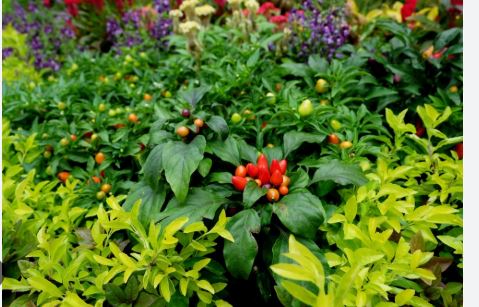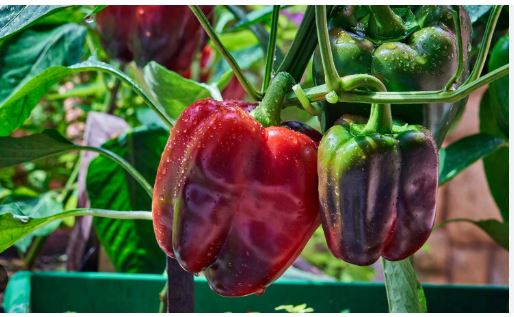
Companion planting for peppers involves selecting plants that enhance growth, deter pests, or optimize garden space. These companions create a balanced ecosystem, supporting peppers by improving soil health, attracting beneficial insects, or providing shade. Choosing plants with similar sunlight and water needs ensures compatibility in the garden.
Certain companions repel pests that commonly affect peppers, such as aphids or spider mites, through natural scents or chemical secretions. Others act as trap crops, drawing harmful insects away from peppers, reducing the need for chemical interventions and promoting organic gardening.
Some companions attract pollinators like bees, boosting pepper fruit production by aiding pollination. They may also draw predatory insects that feed on pests, creating a natural defense system. This synergy enhances pepper yields and plant vigor.
Other companions improve soil conditions by adding nutrients or enhancing drainage, benefiting pepper roots. Some serve as ground cover, retaining moisture and suppressing weeds, which helps peppers thrive in warm, dry conditions.
However, some plants compete with peppers for nutrients or attract similar pests, hindering growth. Proper spacing and crop rotation are essential to maximize the benefits of companions while avoiding conflicts, ensuring a healthy, productive pepper crop.

Best Companion Plants For Peppers
Basil
- Benefits: Basil’s strong aroma repels aphids, spider mites, and whiteflies, common pepper pests. It may also enhance pepper flavor and attract pollinators.
- Planting Tips: Plant basil 12–18 inches from peppers in full sun, ensuring well-drained soil. Pinch back to encourage bushy growth.
- Considerations: Avoid overcrowding, as basil and peppers both need good air circulation to prevent fungal issues.
Marigolds
- Benefits: Marigolds deter nematodes and repel pests like aphids and beetles with their scent. Their bright blooms also attract pollinators.
- Planting Tips: Sow marigolds around pepper plants or in rows, spacing 6–12 inches apart in sunny, fertile soil.
- Considerations: Deadhead spent blooms to maintain pest-repelling effects and continuous flowering.
Onions
- Benefits: Onions’ pungent odor repels aphids, slugs, and other pests that target peppers. They also use minimal space, ideal for interplanting.
- Planting Tips: Plant onions 4–6 inches from peppers in well-drained soil. They thrive in similar sunny conditions.
- Considerations: Harvest onions mid-season to avoid competition with peppers as they mature.
Garlic
- Benefits: Garlic deters spider mites and aphids and has antifungal properties that may reduce pepper diseases like powdery mildew.
- Planting Tips: Plant garlic cloves in fall or spring, 6 inches from peppers, in sunny, well-drained soil.
- Considerations: Garlic’s long growth cycle allows it to coexist with peppers, but harvest carefully to avoid disturbing roots.
Nasturtiums
- Benefits: Nasturtiums act as a trap crop for aphids, luring them away from peppers. Their flowers attract beneficial insects like hoverflies.
- Planting Tips: Sow nasturtiums 1–2 feet from peppers in slightly poorer soil to encourage blooming over foliage.
- Considerations: Monitor their spread, as nasturtiums can sprawl and compete for space if not trimmed.
Oregano
- Benefits: Oregano repels pests like aphids and provides ground cover, reducing weeds and retaining soil moisture for peppers.
- Planting Tips: Plant oregano 12–18 inches from peppers in full sun. It tolerates drier conditions than peppers.
- Considerations: As a perennial, oregano needs pruning to prevent it from overtaking pepper beds.
Chives
- Benefits: Chives deter aphids and spider mites with their onion-like scent and attract pollinators when flowering.
- Planting Tips: Plant chives in clusters 6–12 inches from peppers in sunny, well-drained soil.
- Considerations: Cut back regularly to promote fresh growth and prevent excessive seeding.
Parsley
- Benefits: Parsley attracts predatory insects like ladybugs that eat pepper pests. It also improves soil as it decomposes.
- Planting Tips: Sow parsley 6–12 inches from peppers, ideally at bed edges to avoid shading.
- Considerations: Parsley is biennial, so replace it if it bolts in the second year.
Carrots
- Benefits: Carrots loosen soil with their roots, improving drainage for peppers. Their flowers attract beneficial insects.
- Planting Tips: Sow carrots 6–10 inches from peppers in loose, sandy soil. Thin to 2–3 inches apart.
- Considerations: Harvest carrots early to avoid root competition with maturing peppers.
Alyssum
- Benefits: Alyssum attracts hoverflies and parasitic wasps that prey on pepper pests. Its low growth acts as a living mulch.
- Planting Tips: Sow alyssum seeds around peppers or in borders, spacing 6–8 inches apart in full sun.
- Considerations: Trim alyssum to maintain tidiness and encourage continuous blooming.
Spinach
- Benefits: Spinach shades soil, retaining moisture and suppressing weeds, benefiting peppers in hot climates. It uses space efficiently.
- Planting Tips: Plant spinach 6–10 inches from peppers in early spring or fall to avoid bolting in heat.
- Considerations: Choose heat-tolerant varieties for summer to extend its companion benefits.
Borage
- Benefits: Borage attracts pollinators, boosting pepper fruit set, and deters pests like hornworms. It adds nutrients to soil as it decomposes.
- Planting Tips: Plant borage 2–3 feet from peppers to avoid shading, in sunny, well-drained soil.
- Considerations: Borage self-seeds, so remove spent flowers to control its spread.
Cilantro
- Benefits: Cilantro attracts beneficial insects like lacewings that eat pepper pests. Its flowers also draw pollinators.
- Planting Tips: Sow cilantro 6–12 inches from peppers in spring or fall, as it bolts in heat.
- Considerations: Succession plant every 2–3 weeks for continuous pest control benefits.
Yarrow
- Benefits: Yarrow attracts ladybugs and wasps that control pepper pests. Its deep roots improve soil structure.
- Planting Tips: Plant yarrow 2–3 feet from peppers in full sun, as it can grow tall and spread.
- Considerations: Cut back after flowering to prevent self-seeding and maintain garden order.
Thyme
- Benefits: Thyme’s aroma repels whiteflies and aphids, and its low-growing habit acts as a weed-suppressing ground cover for peppers.
- Planting Tips: Plant thyme 6–12 inches from peppers in full sun, in slightly drier, well-drained soil.
- Considerations: Prune regularly to keep thyme compact and prevent it from becoming woody.
Rosemary
- Benefits: Rosemary deters beetles and aphids with its scent and can provide light shade for young pepper plants in hot climates.
- Planting Tips: Place rosemary 2–3 feet from peppers in sunny, well-drained soil to avoid competition.
- Considerations: As a perennial, rosemary needs a permanent spot or can be grown in pots for flexibility.
Petunias
- Benefits: Petunias repel leafhoppers and aphids while attracting pollinators, boosting pepper fruit set.
- Planting Tips: Sow petunias 12–18 inches from peppers in full sun, ensuring good air circulation.
- Considerations: Deadhead spent blooms to maintain pest-repelling effects and continuous flowering.
Chamomile
- Benefits: Chamomile attracts hoverflies and wasps that prey on pepper pests and improves soil health as it decomposes.
- Planting Tips: Plant chamomile 6–12 inches from peppers in sunny, well-drained soil.
- Considerations: Harvest flowers or trim to control self-seeding and keep the garden tidy.
Radishes
- Benefits: Radishes deter spider mites and loosen soil, improving drainage for pepper roots. They mature quickly, freeing up space.
- Planting Tips: Sow radishes 4–6 inches from peppers in loose, sunny soil, thinning to 2–3 inches apart.
- Considerations: Harvest radishes within 3–4 weeks to avoid competition with pepper roots.
Lettuce
- Benefits: Lettuce acts as a living mulch, shading soil to retain moisture and suppress weeds, benefiting peppers in warm weather.
- Planting Tips: Plant lettuce 6–10 inches from peppers in spring or fall to avoid bolting in heat.
- Considerations: Choose heat-tolerant varieties for summer to extend its benefits.
Catnip
- Benefits: Catnip repels aphids and flea beetles and attracts pollinators when flowering, supporting pepper production.
- Planting Tips: Grow catnip in pots or 1–2 feet from peppers to control its spread, in full sun.
- Considerations: Contain catnip to prevent invasiveness, as it can spread rapidly.
Zinnias
- Benefits: Zinnias attract pollinators and predatory insects like ladybugs, which control pepper pests, and add vibrant color.
- Planting Tips: Sow zinnias 12–18 inches from peppers in sunny, fertile soil, spacing to avoid crowding.
- Considerations: Choose dwarf varieties for smaller gardens to prevent shading peppers.
Beets
- Benefits: Beets loosen soil with their roots, improving drainage, and their small size maximizes garden space around peppers.
- Planting Tips: Sow beets 6–10 inches from peppers in loose, sunny soil, thinning to 2–3 inches apart.
- Considerations: Harvest beets early to minimize root competition with peppers.
Sage
- Benefits: Sage repels pests like cabbage moths and attracts pollinators, enhancing pepper growth and fruit set.
- Planting Tips: Plant sage 12–18 inches from peppers in well-drained, sunny soil.
- Considerations: Prune sage to maintain its shape and prevent it from overtaking pepper space.
Cosmos
- Benefits: Cosmos attract pollinators and beneficial insects like lacewings, which eat pepper pests, and add a light, airy aesthetic.
- Planting Tips: Sow cosmos 1–2 feet from peppers in full sun, spacing 12–18 inches apart.
- Considerations: Use dwarf varieties to avoid shading peppers in smaller gardens.
Bush Beans
- Benefits: Bush beans fix nitrogen in the soil, enriching it for peppers, and deter pests like beetles.
- Planting Tips: Plant bush beans 12–18 inches from peppers in sunny, fertile soil.
- Considerations: Harvest beans regularly to prevent competition and ensure continuous production.
Calendula
- Benefits: Calendula repels nematodes and attracts beneficial insects like hoverflies, protecting peppers from pests.
- Planting Tips: Sow calendula 8–12 inches from peppers in full sun, ensuring good drainage.
- Considerations: Deadhead to prolong blooming and control self-seeding.
Tansy
- Benefits: Tansy repels pests like ants and beetles and attracts predatory insects, supporting pepper health.
- Planting Tips: Plant tansy 2–3 feet from peppers in sunny soil, as it can grow tall.
- Considerations: Tansy can be invasive and toxic to some animals, so contain it in small gardens.
Okra
- Benefits: Okra’s tall structure provides light shade for peppers in hot climates, reducing heat stress. It also attracts pollinators, boosting pepper fruit set.
- Planting Tips: Plant okra 2–3 feet from peppers in full sun, in rich, well-drained soil. Space plants 18–24 inches apart.
- Considerations: Okra grows tall, so position it to avoid shading peppers excessively; harvest pods regularly to maintain plant vigor.
Lovage
- Benefits: Lovage attracts beneficial insects like parasitic wasps that prey on pepper pests and improves soil health with its deep roots.
- Planting Tips: Plant lovage 2–3 feet from peppers in sunny, fertile soil to avoid competition for nutrients.
- Considerations: As a large perennial, lovage needs space; plan for its long-term presence or grow in pots.
Sunflowers
- Benefits: Sunflowers attract pollinators and beneficial insects, enhancing pepper production. They can also act as a windbreak in exposed gardens.
- Planting Tips: Sow sunflowers 3–4 feet from peppers in full sun, using dwarf varieties to minimize shading.
- Considerations: Ensure sunflowers don’t compete for water; stake taller varieties to prevent toppling.
Lemon Balm
- Benefits: Lemon balm’s citrusy scent repels aphids and mosquitoes while attracting bees, supporting pepper pollination.
- Planting Tips: Grow lemon balm in pots or 1–2 feet from peppers in sunny, well-drained soil to control its spread.
- Considerations: Lemon balm can be invasive, so use containers or barriers to prevent it from overtaking pepper beds.
General Tips for Companion Planting with Peppers
- Spacing: Maintain 18–24 inches between peppers and companions to ensure adequate sunlight and air circulation, reducing fungal risks.
- Compatibility: Most companions thrive in peppers’ preferred warm, sunny, well-drained conditions, but monitor water needs (e.g., rosemary prefers drier soil).
- Avoid Antagonists: Keep peppers away from plants like fennel or brassicas, which compete for resources or attract similar pests.
- Crop Rotation: Rotate peppers and companions yearly to prevent soil-borne diseases and maintain soil fertility.